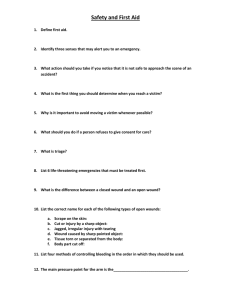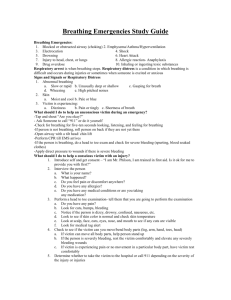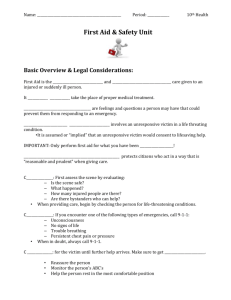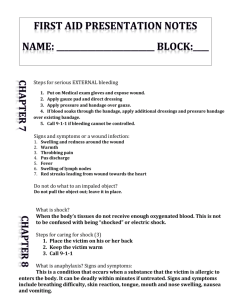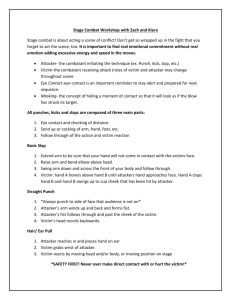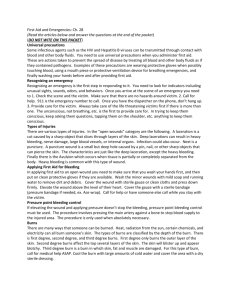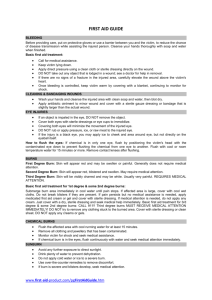call 9-1-1.
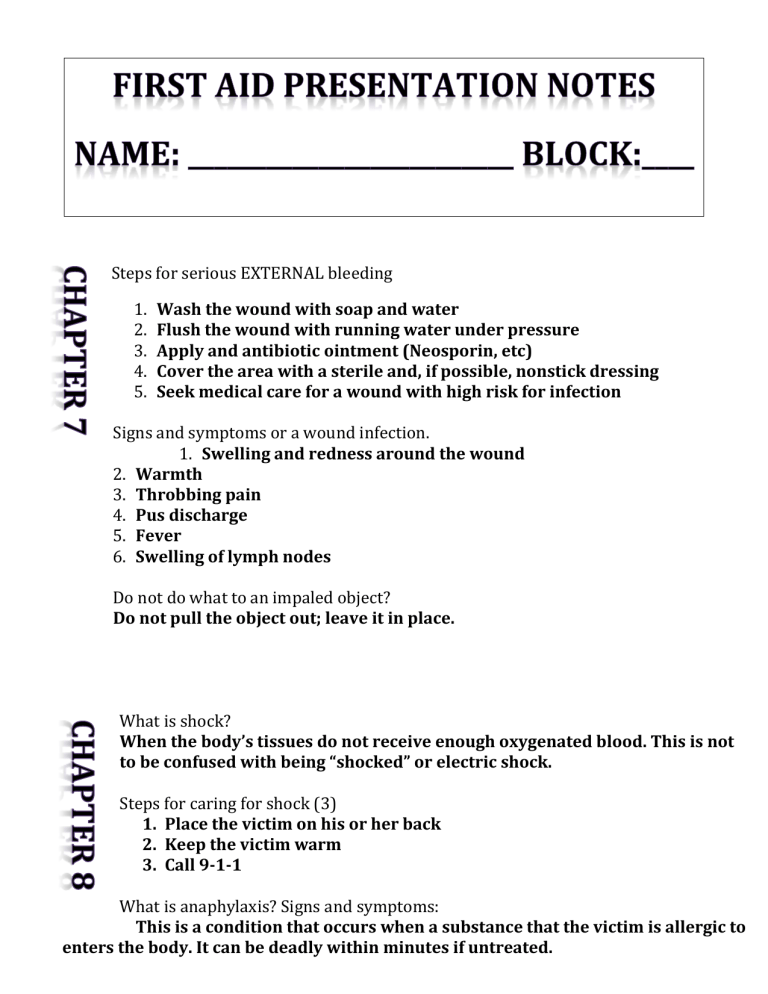
Steps for serious EXTERNAL bleeding
1.
Wash the wound with soap and water
2.
Flush the wound with running water under pressure
3.
Apply and antibiotic ointment (Neosporin, etc)
4.
Cover the area with a sterile and, if possible, nonstick dressing
5.
Seek medical care for a wound with high risk for infection
Signs and symptoms or a wound infection.
1.
Swelling and redness around the wound
2.
Warmth
3.
Throbbing pain
4.
Pus discharge
5.
Fever
6.
Swelling of lymph nodes
Do not do what to an impaled object?
Do not pull the object out; leave it in place.
What is shock?
When the body’s tissues do not receive enough oxygenated blood. This is not to be confused with being “shocked” or electric shock.
Steps for caring for shock (3)
1.
Place the victim on his or her back
2.
Keep the victim warm
3.
Call 9-1-1
What is anaphylaxis? Signs and symptoms:
This is a condition that occurs when a substance that the victim is allergic to enters the body. It can be deadly within minutes if untreated.
Three types of burns
1.
Thermal
2.
Chemical
3.
Electrical
Signs and Symptoms of a 2 nd degree burn:
1.
Burns extend through the skin’s entire layer and into the inner layer
2.
Blisters, swelling, weeping of fluids, and pain are symptoms.
How do you care for a 1 st degree burn?
1.
Cool the burn with cool water until the part is pain free.
2.
After the burn cools, apply an aloe vera gel or skin moisturizer to keep the skin moistened, and to reduce itching and peeling.
3.
Give an over the counter pain medication such as ibuprofen.
Signs of a concussion
1.
Blank stare
2.
Slow to answer questions
3.
Unaware of where they are or day of the week
4.
Slurred speech
5.
Stumbling, inability to walk
6.
Loss of responsiveness
7.
Complaints of headache, dizziness, and nausea within minutes or
hours of injury
8.
Making repetitive statements or asking the same questions over and
over
Steps to care for a nosebleed
1.
Place the victim in a seated position with the victim’s head slightly tilted
forward.
2.
Pinch (or have the victim pinch) the soft parts of the nose between the
thumb and two fingers with steady pressure for 5-10 minutes
3.
Seek medical care if bleeding cannot be controlled or if you suspect a broken nose.
Steps for caring for a spinal injury
1.
Stabilize the head and neck to prevent movement
2.
Check responsiveness and breathing and provide any necessary care. If the
victim vomits, roll the victim onto his/her side.
3.
Call 9-1-1
Signs and symptoms of a rib fracture
1.
Sharp pain, especially when victim takes a deep breath, coughs, or moves.
2.
Shallow breathing
3.
Victim holds the injured area, trying to reduce pain.
How would you care for an internal injury?
1.
Place the victim in a comfortable position with the legs pulled up toward the abdomen
2.
Care for shock
3.
Call 9-1-1.
How would you care for an open stomach wound in which organs were escaping?
1.
Place the victim in a comfortable position with the knees bent and the legs pulled
up toward the abdomen.
2.
Cover protruding organs loosely with a moist, sterile dressing. Do not use
material that apart when wet, such as tissue. Clean plastic wrap or foil is a good
choice is gauze is not available.
A fracture is a break or crack in a bone.
Steps to care for a dislocation
1.
Apply a splint if EMS will be delayed.
2.
Apply ice or a cold pack
3.
Do not try to put the displaced part back into its normal position.
4.
Call 9-1-1.
RICE stands for…
1.
Rest
2.
Ice
3.
Compression
4.
Elevation
How to care for a victim that faints.
1.
Check responsiveness and breathing
2.
Loosen clothing
3.
Check for injuries if victim fell
4.
Call 9-1-1 if: a.
Victim has repeated fainting episodes b.
Does not respond quickly c.
Becomes unresponsive while sitting or lying down d.
Faints for no apparent reason e.
Is elderly
How to care for a victim who has a seizure
1.
Prevent injury by moving away any dangerous objects
2.
Loosen any restrictive clothing
3.
Roll the victim onto his/her side to keep airway clear
4.
Call 9-1-1 for seizures occurring for no known reason.
How to care for a victim in a diabetic emergency
1.
Give sugar, such as one tablespoon, half a can of soda, juice, three glucose tablets,
or one tube of glucose gel.
2.
If no improvement, call 9-1-1.
3.
If the victim is unresponsive, do not give anything by mouth; call 9-1-1.
Steps for caring for INGESTED poisons
1.
Determine the age and size of the victim
2.
What was swallowed
3.
How much was swallowed
Responsive victim:
1.
Call poison control. 1-800-222-1222.
What is activated charcoal?
1.
It is a fine, black, odorless powder that is available as a liquid. It prevents the
absorption of most drugs by the stomach and intestines.
Steps to care for INHALED poisoning.
1.
Get the victim out of the toxic environment and into fresh air.
2.
Check for responsiveness and breathing and provide care as needed.
3.
Call 9-1-1.
4.
Try to determine what substance was involved.
Signs that an animal could be rabid
1.
The animal attacked without provocation
2.
The animal acts strangely out of character
3.
High-risk species (skunk, raccoon, or bat)
How do you care for an animal bite?
1.
If the wound is not bleeding heavily, wash it with soap and water under
pressure.
2.
Flush the wound thoroughly with running water.
3.
Control bleeding and cover the wound with a sterile or clean dressing.
4.
Seek medical care for further wound cleaning and closure, and possible tetanus
or rabies care.
How do you care for a tick bite?
1.
Remove the tick with tweezers or a special tick-removal tool. Grasp the tick as
close to the skin as possible.
2.
Wash the area with soap and water or use an antiseptic
3.
Apply ice or a cold pack
4.
Seek medical care if the tick was attached for more than a few hours.
What causes Heat Exhaustion?
1.
Loss of water and salt through heavy sweating.
2.
Working or exercising in hot environments.
How do you care for Heatstroke?
1.
Call 9-1-1
2.
Cool the victim immediately by whatever means possible: a.
Cool, wet towels or sheets to the head and body b.
Fanning and/or cold packs against the armpits, sides of neck/groin
3.
If unresponsive and not breathing, start CPR.
What 4 body parts are most likely Affected by frostbite?
1.
Feet
2.
Hands
3.
Ears
4.
Nose
What are the key points of a water rescue?
“Reach-Throw-Row-Go”
What are the key points of an ice rescue?
1.
Extend a pole or throw a line with a floatable object attached to it.
2.
When the person has hold of the object, pull him or her to the shore or the edge of the ice.
What are the key points of helping with a car accident?
1.
Call 9-1-1
2.
Turn on your vehicle’s emergency hazard flashers. Raise the hood to draw
attention.
3.
Make sure the scene is safe before approaching the crash.
4.
Ask the driver to turn off the ignition.
5.
Place flares or reflectors 250-500 feet behind the crash scene.
6.
If you suspect a spinal injury, use your hands to stabilize the person’s head and
neck.
7.
Check and care for any life-threatening injuries first, and then handle lesser
injuries.


